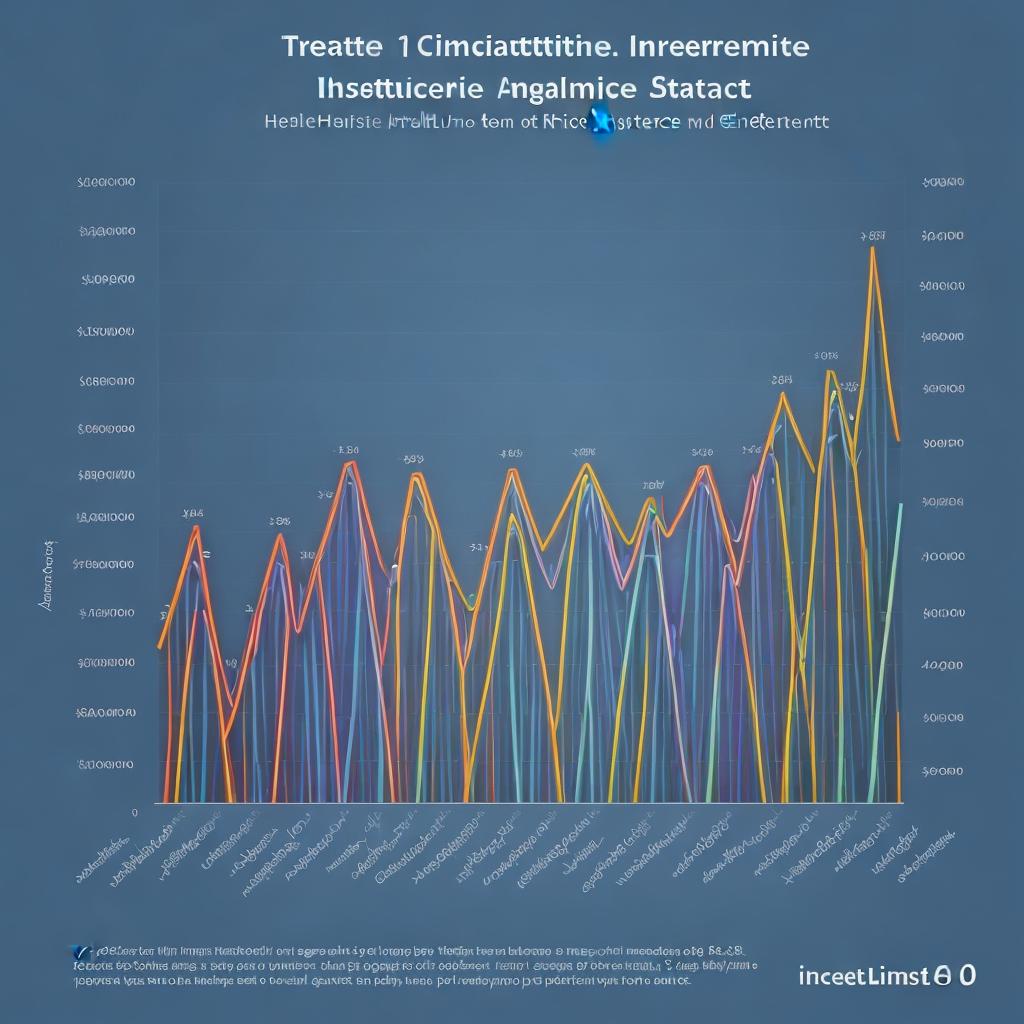Top 10 Current Trends in Healthcare Enrollment Statistics

Did you know that healthcare enrollment statistics are constantly evolving? In fact, there are currently 10 top trends shaping the landscape.
From shifting demographics to the impact of healthcare reform, these trends are revolutionizing how people access and engage with healthcare services.
With the increasing importance of technology and data analytics, enrollment processes are becoming more efficient and personalized.
Join us as we explore these trends and their implications on the future of healthcare enrollment.
Key Takeaways
- Affordable Care Act has led to a significant increase in the number of individuals enrolled in healthcare programs, including Medicaid and private insurance.
- The enrollment statistics have seen a shift in demographics, with a higher percentage of young adults and previously uninsured individuals enrolling in healthcare programs.
- Technology has played a crucial role in streamlining enrollment processes, offering online platforms, electronic health records integration, and telemedicine for remote enrollment.
- There has been a rise in private insurance enrollment rates, driven by factors such as the changing employment landscape, implementation of the Affordable Care Act, availability of subsidies, and advancements in technology.
Shifting Demographics and Enrollment Patterns
In this article, we’ll discuss the shifting demographics and enrollment patterns in healthcare. It’s crucial to analyze these trends to better understand the current landscape of healthcare enrollment.
One significant shift that has been observed is the aging population and its impact on healthcare enrollment. As the baby boomer generation continues to age, there’s an increasing demand for healthcare services, resulting in a rise in enrollment rates.
Moreover, the changing racial and ethnic composition of the population also plays a role in enrollment patterns. The United States is becoming more diverse, with minority populations growing at a faster rate than the white population. This diversity brings about unique healthcare needs and preferences, leading to variations in enrollment across different racial and ethnic groups.
Additionally, the emergence of new healthcare legislation and policies has had a considerable impact on enrollment. The Affordable Care Act, for instance, aimed to increase access to healthcare for previously uninsured individuals, resulting in a significant surge in enrollment.
Impact of Healthcare Reform on Enrollment Statistics
The impact of healthcare reform on enrollment statistics is a significant aspect to consider. With the implementation of reforms, such as the Affordable Care Act, there have been notable changes in enrollment patterns.
These changes include an increase in the number of individuals who now have access to healthcare coverage, as well as shifts in demographics and the types of plans chosen.
Understanding how healthcare reform has influenced enrollment statistics is crucial in assessing the effectiveness of these policies and informing future decision-making.
Reform’s Effect on Enrollment
Healthcare reform significantly impacts enrollment statistics, with a notable effect on the number of individuals enrolled in healthcare programs.
The implementation of healthcare reform has led to changes in the enrollment landscape, as more individuals are now able to access affordable healthcare coverage.
According to recent data, the number of uninsured individuals has decreased since the implementation of healthcare reform, with millions gaining coverage through the expansion of Medicaid and the establishment of health insurance marketplaces.
These reforms have also resulted in changes in the demographics of enrollees, with a higher percentage of young adults and previously uninsured individuals now enrolling in healthcare programs.
As a result, the overall enrollment statistics have been shifting, reflecting the impact of healthcare reform on the accessibility and availability of healthcare coverage.
In the subsequent section, we’ll explore these changing enrollment statistics in more detail.
Changing Enrollment Statistics
As you delve into the topic of changing enrollment statistics, you’ll notice a significant impact on the number of individuals enrolled in healthcare programs due to the implementation of healthcare reform. The reform has brought about several shifts in enrollment statistics that are worth considering:
- Increased number of individuals with coverage: The implementation of healthcare reform has resulted in a higher number of individuals gaining access to healthcare coverage. This is primarily due to the expansion of Medicaid and the creation of health insurance marketplaces.
- Changing demographics of enrollees: With the reform, there’s been a noticeable shift in the demographics of those enrolling in healthcare programs. More young adults and previously uninsured individuals have been able to obtain coverage, leading to a more diverse pool of enrollees.
- Impact on private insurance market: The reform has also had an impact on the private insurance market, with some individuals transitioning from employer-sponsored insurance to marketplace plans. This has led to changes in the dynamics of the insurance market.
These changes in enrollment statistics highlight the transformative effect of healthcare reform on the healthcare landscape, as more individuals gain access to essential healthcare services.
Increasing Importance of Technology in Enrollment Processes
Have you ever wondered how technology is revolutionizing the enrollment processes in healthcare? The increasing importance of technology in enrollment processes has significantly transformed the way healthcare organizations handle enrollment. With the advancements in technology, healthcare providers can now streamline their enrollment processes, making it more efficient and convenient for both patients and healthcare professionals.
One of the key ways technology is enhancing enrollment processes is through the implementation of online enrollment platforms. These platforms allow individuals to complete enrollment forms electronically, eliminating the need for paper forms and manual data entry. This not only saves time but also reduces the risk of errors in data entry, ensuring accurate and up-to-date information.
Furthermore, technology has enabled the integration of electronic health records (EHRs) into the enrollment process. EHRs store patients’ medical information electronically, making it easily accessible during the enrollment process. This integration eliminates the need for patients to provide redundant information and allows healthcare providers to make informed decisions based on the patient’s medical history.
Another significant impact of technology on enrollment processes is the use of telemedicine. With telemedicine, individuals can enroll in healthcare services remotely, without the need for in-person visits. This not only increases convenience and accessibility but also enables healthcare providers to reach individuals in remote or underserved areas.
Rise in Private Insurance Enrollment Rates
You may be interested to know that the rise in private insurance enrollment rates has had a significant impact on healthcare costs. As more individuals opt for private insurance, the overall cost of healthcare increases due to higher premiums and increased utilization of healthcare services.
Several factors are driving this trend, including the increasing cost of employer-sponsored insurance and the availability of subsidies for private insurance plans.
It’s worth comparing the benefits and drawbacks of public versus private insurance to understand the implications of this rise in enrollment.
Impact on Healthcare Costs
One significant trend in healthcare enrollment statistics is the 10% increase in private insurance enrollment rates, which has led to a significant impact on healthcare costs.
This rise in private insurance enrollment rates has several implications for healthcare costs:
- Increased demand for healthcare services: With more individuals having private insurance coverage, there’s a higher demand for healthcare services. This increased demand puts pressure on healthcare providers to meet the growing healthcare needs, resulting in higher costs.
- Rising healthcare prices: As the demand for healthcare services increases, healthcare providers may raise prices to meet the demand. This can lead to higher healthcare costs for both individuals and insurance companies.
- Increased utilization of healthcare services: With private insurance coverage, individuals are more likely to utilize healthcare services, resulting in increased healthcare costs. This includes visits to doctors, hospital stays, and prescription medication.
Factors Driving Enrollment
With the rise in private insurance enrollment rates, it’s important to understand the factors that are driving this increase. One major factor contributing to the surge in private insurance enrollment is the changing employment landscape. As the economy continues to recover, more individuals are gaining employment, which often comes with the benefit of employer-sponsored health insurance.
Additionally, the implementation of the Affordable Care Act (ACA) has played a significant role in driving private insurance enrollment rates. The ACA introduced subsidies and tax credits to make private insurance more affordable for individuals and families, leading to an increase in enrollment.
Furthermore, advancements in technology and the availability of online platforms have made it easier for individuals to research and compare different private insurance plans, ultimately driving up enrollment rates.
Comparing Public Vs Private
The rise in private insurance enrollment rates is driven by various factors. Comparing public versus private healthcare coverage reveals significant differences.
Private insurance offers individuals more choices and flexibility in terms of providers and services. It often provides access to a wider network of doctors and specialists, delivering faster and more personalized care. Additionally, private insurance plans tend to have shorter wait times for treatments and procedures.
However, private insurance can be more expensive than public options and may have higher deductibles and out-of-pocket costs. It also tends to offer more comprehensive coverage for elective procedures and alternative therapies.
Challenges in Medicaid and CHIP Enrollment
When enrolling in Medicaid and CHIP, it can be challenging to navigate the complex eligibility requirements and application process. These challenges stem from a variety of factors that can hinder individuals from accessing the healthcare coverage they need. One major challenge is the lack of awareness about eligibility criteria and the application process itself. Many eligible individuals are unaware of their eligibility status or don’t know how to apply for coverage, leading to a significant gap in enrollment.
Additionally, the paperwork and documentation required for enrollment can be overwhelming, particularly for individuals with limited resources or language barriers.
Another challenge lies in the administrative burdens associated with Medicaid and CHIP enrollment. This includes lengthy waiting periods, cumbersome paperwork, and the need for frequent eligibility renewals. These administrative hurdles can discourage individuals from completing the enrollment process or cause them to inadvertently lose coverage.
Furthermore, limited provider networks can pose a challenge for Medicaid and CHIP enrollees. Access to healthcare services may be restricted due to a lack of participating providers or long wait times for appointments. This can lead to delays in receiving necessary care and potentially worsen health outcomes for beneficiaries.
In conclusion, the challenges in Medicaid and CHIP enrollment are multi-faceted and can significantly impede individuals’ access to healthcare coverage. From lack of awareness to administrative burdens and limited provider networks, these obstacles must be addressed to ensure that eligible individuals can successfully enroll and receive the healthcare services they need.
Transition: As we explore the challenges faced in Medicaid and CHIP enrollment, it’s also important to examine the changing trends in employer-sponsored coverage.
Changing Trends in Employer-Sponsored Coverage
Employer-sponsored coverage has seen a decline in recent years, with many individuals opting for alternative options. According to recent data, the percentage of Americans with employer-sponsored health insurance has been steadily decreasing, while the number of people enrolling in individual plans or government programs has been on the rise.
This shift in trends indicates a changing landscape in healthcare enrollment, as individuals seek out coverage that best fits their needs and circumstances.
Declining Employer-Sponsored Coverage
If you’re considering healthcare enrollment, it’s important to note the changing trends in employer-sponsored coverage. In recent years, there’s been a decline in the number of employers offering health insurance to their employees. This shift has significant implications for individuals seeking healthcare coverage.
Here are three key points to consider:
- Decreasing availability: Many companies are facing rising healthcare costs, leading them to cut back on offering insurance benefits. As a result, fewer individuals have access to employer-sponsored coverage.
- Increasing out-of-pocket expenses: With the decline in employer-sponsored coverage, more people are being forced to seek coverage through other means, such as the individual marketplace. This often leads to higher out-of-pocket costs for individuals and their families.
- Shifting responsibility: As the burden of healthcare coverage falls more on individuals, it’s crucial to understand the options available and consider factors such as affordability, quality of coverage, and the potential for financial assistance.
Understanding these changing trends is essential for making informed decisions about healthcare enrollment.
Rise of Alternative Options
With the declining availability of employer-sponsored coverage, it’s important for you to explore the rise of alternative options for healthcare enrollment. As the landscape of healthcare coverage evolves, individuals and families are seeking out alternative options to meet their healthcare needs. These alternative options include government programs like Medicaid and CHIP, individual marketplaces, and short-term health insurance plans. To help you understand the changing trends in employer-sponsored coverage, here is a comparison table highlighting the key features and benefits of these alternative options:
| Alternative Options | Key Features and Benefits |
|---|---|
| Medicaid | Provides low-cost or free healthcare coverage to eligible individuals and families with limited income. |
| CHIP | Offers affordable health coverage for children in families that earn too much to qualify for Medicaid. |
| Individual Marketplaces | Allows individuals to purchase health insurance plans that best fit their needs and budget. |
| Short-term Health Insurance Plans | Provides temporary coverage for individuals in need of gap coverage or those experiencing a life transition. |
As employer-sponsored coverage becomes less accessible, these alternative options offer individuals and families the opportunity to find affordable and comprehensive healthcare coverage that suits their unique circumstances.
Impact of COVID-19 on Healthcare Enrollment Statistics
The COVID-19 pandemic has significantly affected healthcare enrollment statistics. As people grapple with the impact of the virus on their health and finances, there have been notable shifts in healthcare enrollment patterns.
Here are three key ways in which COVID-19 has influenced healthcare enrollment:
- Increased demand for healthcare coverage: The pandemic has highlighted the importance of having access to healthcare services. As a result, many individuals who were previously uninsured or underinsured have sought out health insurance options to protect themselves and their families during these uncertain times.
- Changes in employer-sponsored coverage: The economic fallout from the pandemic has led to job losses and reduced work hours for many individuals. Consequently, there’s been a significant decrease in employer-sponsored health insurance coverage. This has forced many people to explore other avenues, such as Medicaid or health insurance marketplaces, to secure affordable healthcare coverage.
- Telemedicine adoption: To adhere to social distancing measures and minimize the risk of exposure, telemedicine has emerged as a popular alternative to in-person healthcare visits. The increased utilization of telehealth services has prompted individuals to reevaluate their healthcare needs and explore insurance plans that offer comprehensive telemedicine coverage.
These trends indicate the profound impact that COVID-19 has had on healthcare enrollment statistics. As the pandemic continues to unfold, it’s crucial to closely monitor these changes and adapt healthcare enrollment strategies accordingly.
Barriers to Enrollment and Strategies for Improvement
To overcome barriers to enrollment and improve healthcare access, you can explore strategies that address the challenges highlighted by the impact of COVID-19 on healthcare enrollment statistics.
The pandemic has exacerbated existing barriers and created new ones, making it crucial to identify effective solutions.
One major barrier is the lack of awareness and understanding about available healthcare options. Many individuals are unaware of the enrollment process, eligibility requirements, and available subsidies.
To address this, targeted education campaigns can be implemented to inform and empower individuals to navigate the enrollment process successfully.
Additionally, the digital divide has become more apparent during the pandemic, with limited internet access and technological literacy hindering enrollment. Strategies such as providing assistance in filling out online applications, expanding broadband access, and offering technology training can help bridge this gap.
Financial barriers, including high premiums and out-of-pocket costs, also deter enrollment. Implementing policies that lower costs, such as expanding Medicaid coverage and offering more affordable insurance options, can make healthcare more accessible.
Finally, language and cultural barriers can pose significant challenges to enrollment. Offering multilingual resources, cultural competency training for enrollment staff, and partnering with community organizations can help address these barriers.
Growing Importance of Data Analytics in Enrollment Management
Utilize data analytics to enhance enrollment management and improve healthcare access. Data analytics plays an increasingly vital role in enrollment management in the healthcare industry. By analyzing large volumes of data, healthcare organizations can gain valuable insights into enrollment trends, patterns, and behaviors.
Here are three key reasons why data analytics is becoming increasingly important in enrollment management:
- Identifying target populations: Data analytics allows healthcare organizations to identify specific populations that are most in need of healthcare coverage. By analyzing demographic, geographic, and socioeconomic data, organizations can target their enrollment efforts towards those who are most likely to benefit from their services.
- Predicting enrollment patterns: With the help of data analytics, healthcare organizations can predict enrollment patterns and anticipate future demands for healthcare services. This enables them to allocate resources effectively, ensure sufficient healthcare access, and optimize their enrollment strategies.
- Improving enrollment processes: Data analytics can identify bottlenecks and inefficiencies in the enrollment process, enabling organizations to streamline their operations. By analyzing data on enrollment timeframes, application completion rates, and customer satisfaction, organizations can make data-driven decisions to improve the enrollment experience for individuals seeking healthcare coverage.
Future Outlook and Predictions for Healthcare Enrollment Trends
You can expect significant changes and advancements in healthcare enrollment trends in the near future. As technology continues to advance and consumer expectations evolve, the healthcare industry is poised for transformation. Here are some predictions for the future of healthcare enrollment:
| Prediction | Explanation |
|---|---|
| Increased personalization | Healthcare enrollment will become more personalized, taking into account individual needs and preferences. This could involve tailored communication and recommendations based on data analysis. |
| Simplified enrollment processes | The enrollment process is likely to become more streamlined and user-friendly, reducing paperwork and administrative burdens. Online platforms and self-service options will make it easier for individuals to enroll in healthcare plans. |
| Greater emphasis on preventive care | Healthcare enrollment will focus more on preventive care, encouraging individuals to take proactive steps to maintain their health. Wellness programs and incentives for healthy behaviors may be integrated into enrollment processes. |
These predictions are driven by the growing importance of data analytics in enrollment management. By leveraging data, healthcare providers can gain insights into consumer behavior and preferences, allowing for more targeted and efficient enrollment strategies. The future of healthcare enrollment holds great potential for improving the overall experience and outcomes for individuals seeking healthcare coverage.
Frequently Asked Questions
What Are the Specific Demographic Shifts and Patterns in Healthcare Enrollment That Are Currently Being Observed?
You’re wondering about the specific demographic shifts and patterns in healthcare enrollment being observed. Well, let’s dive in and examine the data to uncover the latest trends in healthcare enrollment statistics.
How Has Healthcare Reform Influenced Enrollment Statistics in Recent Years?
How has healthcare reform influenced enrollment statistics in recent years? The implementation of healthcare reform has led to significant shifts in enrollment numbers, with more individuals gaining access to insurance coverage and increased overall enrollment rates.
What Are Some Examples of Technological Advancements That Have Improved the Enrollment Process in Healthcare?
Technological advancements have greatly improved the enrollment process in healthcare. Examples include online portals, mobile apps, and automated systems that streamline the application process, reducing paperwork and allowing for quicker and more efficient enrollment.
What Factors Have Contributed to the Increase in Private Insurance Enrollment Rates?
Factors contributing to increased private insurance enrollment rates include expanded Medicaid eligibility, individual mandate penalties, and employer-sponsored coverage. These measures incentivize individuals to obtain coverage, resulting in higher enrollment rates.
How Has the COVID-19 Pandemic Affected Healthcare Enrollment Statistics?
The COVID-19 pandemic has had a significant impact on healthcare enrollment statistics. Many people have lost their jobs and employer-sponsored health coverage, leading to an increase in enrollment in government-sponsored healthcare programs like Medicaid.



